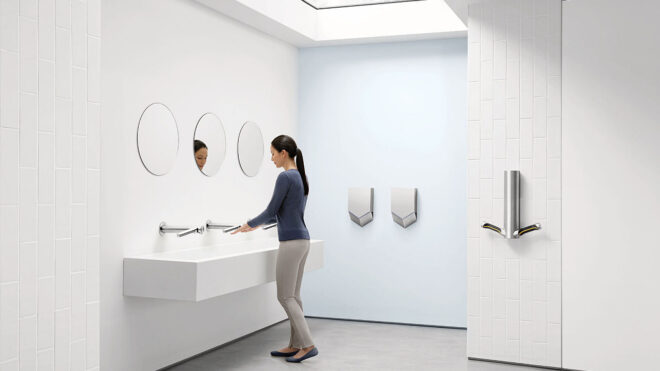Making a difference with its research on hand hygiene and the products it develops in this field. Dysonshares important information about hand drying by shedding light on a little-known step that plays a very important role in the hand hygiene process.
While effective hand drying is key to keeping hands clean, hygiene risks arise if this does not occur. It is known that wet hands can collect more bacteria than dry ones. What’s more, damp hands can carry up to 1,000 times more bacteria than dry hands, and wiping hands on clothing can transfer bacteria to washed hands if the clothes aren’t clean. That’s why ensuring people can wash and dry their hands properly is so important. Bacteria cannot be seen with the naked eye. For example, imagine one hand is wet and one hand is dry, you put both hands into the glitter and what do you think happens? While your wet hand will be covered in glitter, your dry hand will collect less glitter. This process can tell you the difference between wet and dry hands interacting with germs and bacteria, they actually exist but we just can’t see it with the naked eye. But the real problem isn’t that restrooms don’t offer hand drying options, it’s that the options offered can actually cause hygiene issues, environmental challenges and cost concerns.
YOU MAY BE INTERESTED IN
While many public toilets have one of the hand dryer or paper towel options, in some toilets we can see both options together. In addition to hygiene issues that may arise from the design of hot air hand dryers, such as physical buttons, long drying times and other technological limitations, the lack of air filtration in these machines is a common problem.
These problems affect hygiene conditions and are a source of great concern for users. According to the Global Hygiene Research conducted by Dyson in 2021, Turkish participants, who are hesitant to use traditional hand dryers that emit dirty air in public toilets, prefer state-of-the-art devices that provide contactless hand drying and have a clean air filter instead of traditional technologies.
On the other hand, although paper towels do not generally cause hygiene problems, they can also bring environmental problems that cannot be ignored in today’s world. Producing, transporting and disposing of them on a large scale requires processes with higher CO2 (Carbon Dioxide) emissions.
As society becomes increasingly aware of environmental issues and the sustainability of the products they use, creating hand drying solutions that address these issues becomes a necessity.
At a time when businesses are embedding sustainability at their core and creating Corporate Social Responsibility teams to demonstrate their work towards progress, there are significant opportunities to stand out and make public restrooms a point of differentiation.
The “fastest” and “most efficient” HEPA filter hand dryer of all time: Airblade 9kJ
Dyson Airblade 9kJ hand dryer, which emerged as a result of more than three years of work after more than 700 prototypes, is the fastest and quietest to date with a 10-second fast drying performance. Dyson Airblade was designed as a hand dryer.
The motor and Air Flow technology used by Dyson enable the Dyson Airblade 9kJ hand dryer to use 87 percent less energy in Economic Mode compared to other hot air dryers. It also produces 85 percent less carbon dioxide emissions per piece than paper towels.
Curved Blade design
Powered by the Dyson digital engine V4, which rotates at 75 thousand revolutions per minute, Dyson Airblade 9kJ releases airflow at a speed of 624km/h from the holes with its 2 0.45mm curved openings and dries the water in a shorter time by following the surface of your hands.
The powerful Dyson digital engine V4 enables the Dyson Airblade 9kJ hand dryer to quickly dry your hands in 10 seconds by displacing 23 liters of air per second. Dyson Airblade 9kJ hand dryer uses 9.1 kilojoules of energy per drying, which creates a cost of only 325 TL per year when operated in Economic mode.
YOU MAY BE INTERESTED IN
Contactless use
The machine uses “Time of Flight” sensors that detect your hands to activate air.
Hygienic HEPA filtration
The machine, which captures 99.95 percent of particles from toilet air with a fleece-lined glass fiber HEPA filter, uses clean air to dry your hands.
acoustic engineering
Dyson’s quietest hand dryer yet, the Airblade 9kJ features silencers made of open-cell foam and perforated discs that reduce noise as the airflow passes through the motor. To reduce noise, Dyson redesigned the airflow paths in the machine, making them more direct and reducing the sound produced.
The motor body of the Dyson digital motor V4 regulates the air flow paths in the motor, reducing noisy turbulence. The engine is mounted on silicone rubber to further reduce noise, and specially designed open-cell foam mufflers absorb vibrations in the air entering and leaving the engine.
The Dyson Airblade 9kJ hand dryer is designed to fit any commercial or public restroom, from offices to shopping centres, restaurants to public spaces, parks to schools, hospitals and hotels.
